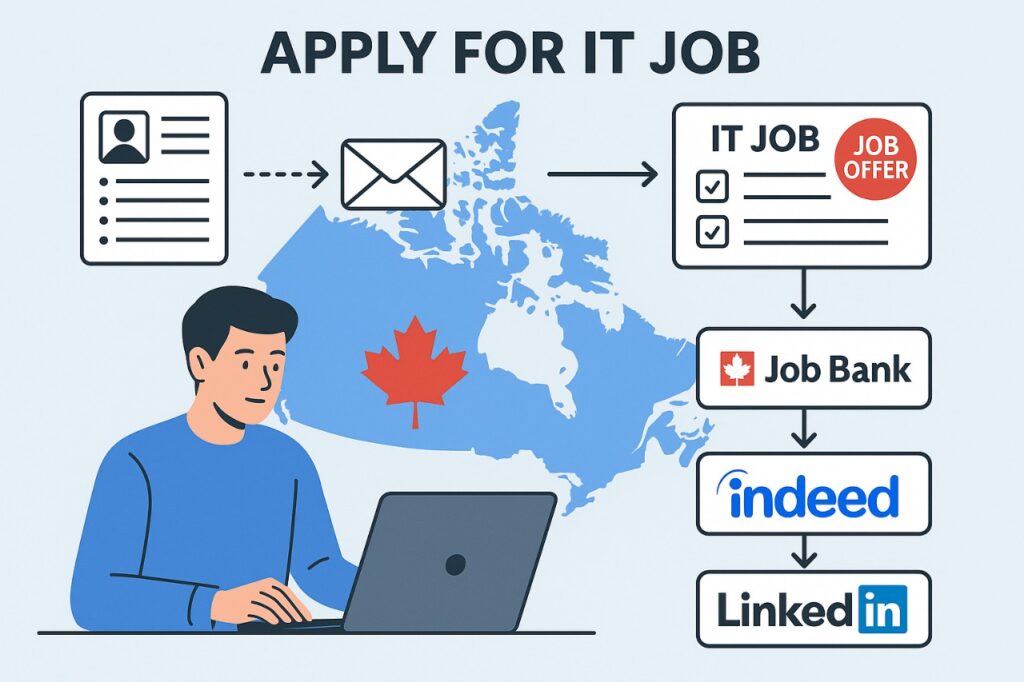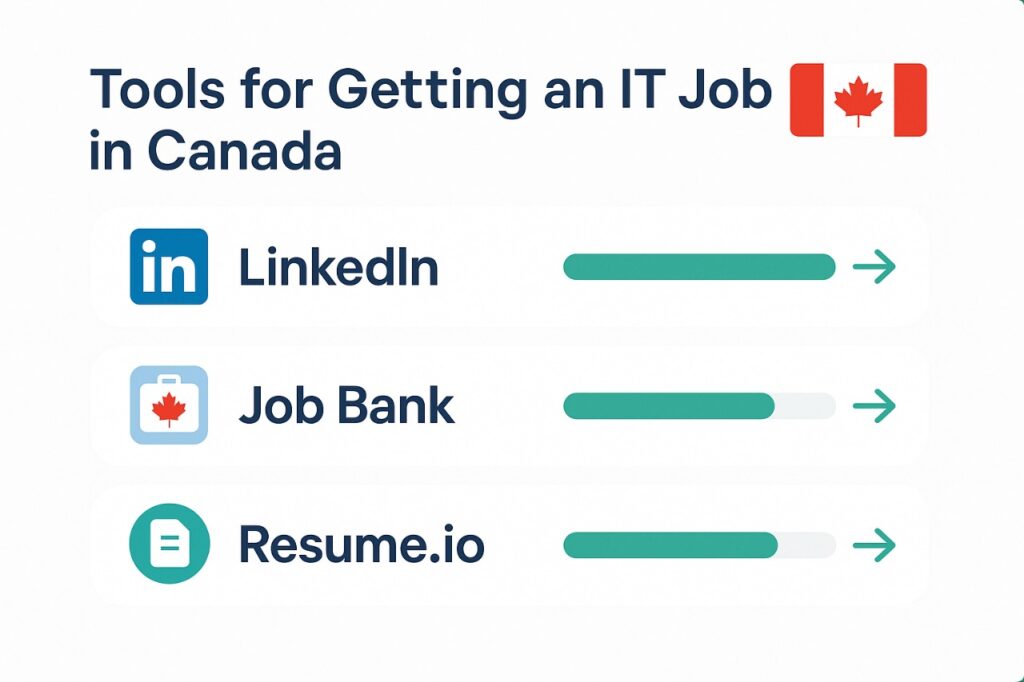Table of Contents
Introduction
The demand for skilled tech talent continues to surge, and Canada has positioned itself as one of the most attractive destinations for IT professionals globally. Yet, for international applicants, securing IT Jobs In Canada involves more than submitting a resume—it’s about knowing the system, optimizing your profile, and aligning with Canadian market needs.
This guide is designed to walk you through the precise steps required to land an IT Jobs In Canada in 2025. Whether you’re a fresh graduate, an experienced developer, or a digital professional looking to relocate, this tutorial lays out actionable strategies tailored to today’s job market.
By the end, you’ll understand what employers are seeking, how to prepare your documents, where to apply, and how to navigate the visa process. With 8 logical steps, this guide requires around 3–4 weeks of strategic effort and suits anyone from intermediate to advanced tech backgrounds.

Prerequisites/Requirements
Before applying for IT Jobs In Canada, make sure you meet these essentials:
- Skills: Proficiency in tech stacks like JavaScript, Python, SQL, AWS, or DevOps depending on your role.
- Language: English fluency (IELTS General 6+ or CLB equivalent recommended).
- Documents: A well-structured resume (Canadian format), cover letter, and LinkedIn profile.
- Experience Level: Intermediate to advanced professionals fare better, though juniors can target internships.
- Budget: $100–$500 for documentation, visa fees, and certifications.
- Alternative Path: Enroll in Canadian diploma/certificate programs if you lack work experience.
Step-by-Step Process
Step 1: Research In-Demand IT Jobs In Canada
Use websites like Canada Job Bank, Indeed Canada, and Glassdoor to identify high-demand roles like:
- Software Engineer
- Cloud Architect
- Cybersecurity Analyst
- Data Scientist
- DevOps Engineer
Pro Tip: Explore provincial programs like Ontario Tech Draw or BC PNP Tech that favor specific IT occupations.
Step 2: Tailor Your Resume to Canadian Standards
Canadian resumes prioritize clarity, brevity, and measurable achievements.
- Use reverse chronological format
- Include a professional summary
- Avoid personal data (e.g., age, photo)
Common Mistake: Using a CV instead of a resume. In Canada, resumes are 1-2 pages max.
Step 3: Optimize Your LinkedIn Profile
Many Canadian recruiters use LinkedIn as a first step.
- Add keywords from
- IT Jobs In Canada descriptions
- Request recommendations
- Enable “Open to Work” for international relocation
Progress Indicator: 100% profile strength on LinkedIn.
Step 4: Apply on Canadian Job Portals
Top platforms include:
- JobBank.gc.ca (official government site)
- Monster.ca
- Indeed.ca
- Workopolis
- Stack Overflow Jobs
Apply daily with customized cover letters using keywords from the job posting.
Troubleshooting Tip: If you’re not getting responses, rework your resume or target roles with lower competition.

Step 5: Target Companies That Sponsor Foreign Workers
Look for employers registered under Canada’s LMIA system or Global Talent Stream.
- Visit Canada.ca > Employers hiring foreign workers
- Filter job posts mentioning “willing to sponsor” or “LMIA available”
Pro Tip: Mid-sized firms often sponsor faster than big tech.
Step 6: Prepare for Canadian Interviews
Focus on soft skills, communication, and culture fit.
- Practice STAR method (Situation, Task, Action, Result)
- Be honest about visa status
- Familiarize with Canadian workplace etiquette
Avoid: Over-explaining or overly technical answers. Keep it concise and professional.
Step 7: Apply for a Work Visa or Express Entry
If you receive a job offer, apply for:
- Employer-specific Work Permit
- Express Entry under FSWP or CEC
- Global Talent Stream (expedited processing)
Tip: Use immigration consultants only if necessary; many do it independently via Canada.ca.
Step 8: Relocate and Network Locally
Once in Canada:
- Join meetups (e.g., Meetup.com/techgroups)
- Attend industry events and conferences
- Consider co-working spaces for networking
Expected Outcome: Faster job transitions or contract opportunities.
Advanced Tips & Best Practices
- Certifications: Boost chances with AWS, Azure, or CompTIA Security+
- Freelance First: Consider Upwork or Toptal to build Canadian references remotely
- Cold Emailing: Reach out directly to hiring managers with tailored pitches
- Referral Systems: Get introductions through LinkedIn or forums like r/ImmigrationCanada
- Localization: Adapt resumes using Canadian spelling and formats
- Daily Effort: Spend at least 2 hours/day for 4–6 weeks to see results
- Persistence Wins: Rejection is common. Consistency is the key
Tools & Resources
| Tool/Resource | Type | Notes |
|---|---|---|
| Job Bank Canada | Free | Official job portal |
| Free/Paid | Recruiter access and networking | |
| Resume.io | Freemium | Canadian-style resume builder |
| ArriveCan/Immigration | Free | Travel and visa support |
| CanadaVisa Forums | Free | Community-driven immigration help |
- Free vs Paid: Paid tools (like premium LinkedIn) improve visibility but aren’t mandatory
- Compatibility: Resume.io exports compatible formats for Canadian portals
- Community: Use subreddits and Discord groups to learn from real applicants

Measuring Success & Optimization
- KPIs: Interview invites, profile views, recruiter responses
- Tracking Tools: Google Sheets, Notion, or Trello
- Improvement: Tweak applications after 10+ no-response submissions
- Benchmarks: 1 interview per 20 targeted applications is average
- Adjustments: Rotate job roles, rewrite summaries, A/B test resumes
Next Steps & Advanced Techniques
Once employed or settled:
- Upskill through Canadian institutions like Coursera, York University, or edX
- Join organizations like ICTC Canada
- Volunteer in open-source or tech non-profits
- Subscribe to newsletters (Toronto Tech Jobs, TechTO)
- Start side projects or local internships for PR advantage
Conclusion
Landing IT Jobs In Canada in 2025 requires more than skill—it’s about alignment with the system. By tailoring your application, leveraging immigration streams, and staying persistent, your goal is achievable.
Now that you understand the roadmap, implement these strategies consistently and smartly. The Canadian IT market awaits global talent like you.
Call-to-Action:
Start today by customizing your resume and applying to three IT Jobs In Canada portals. Consistency creates opportunities.
How long does it take to get an IT job in Canada?
Typically, 3–6 months depending on your skill level, application volume, and visa status. Consistent applications and tailoring increase chances.
What if I don’t have Canadian experience?
Consider remote freelance jobs with Canadian clients, international internships, or certifications to build relevance.
Do I need a job offer for a work visa?
Yes, for Employer-Specific Work Permits. However, Express Entry doesn’t require a job offer, though it adds extra points.
Can I apply to IT jobs in Canada from outside the country?
Yes. Use portals like JobBank or reach out directly. Mention your willingness to relocate and check for visa sponsorship.
Which IT roles are easiest to get in Canada?
Software Developers, DevOps Engineers, Data Analysts, and Cloud Specialists are in high demand and easier to access with proper experience.
Internal Links:
- Learn the basics in our Canadian Resume Format Guide
- Master advanced techniques with our jobs with work permits
- Check our comprehensive canada farm jobs 2025
External Links:
- Job Bank Canada – Official job site
- Immigration, Refugees and Citizenship Canada
- Resume.io Canada
Consistency + Strategy = Success in landing IT jobs in Canada in 2025. 🇨🇦💼 #CareerGoals





